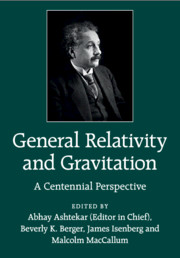Book contents
- Frontmatter
- Contents
- Preface
- List of contributors
- List of figures
- List of tables
- Part One Einstein's Triumph
- 1 100 Years of General Relativity
- 2 Was Einstein Right? A Centenary Assessment
- 3 Relativistic Astrophysics
- 4 Cosmology
- Part Two New Window on the Universe: Gravitational Waves
- Part Three Gravity is Geometry, after all
- Part Four Beyond Einstein
- Index
- References
3 - Relativistic Astrophysics
from Part One - Einstein's Triumph
Published online by Cambridge University Press: 05 June 2015
- Frontmatter
- Contents
- Preface
- List of contributors
- List of figures
- List of tables
- Part One Einstein's Triumph
- 1 100 Years of General Relativity
- 2 Was Einstein Right? A Centenary Assessment
- 3 Relativistic Astrophysics
- 4 Cosmology
- Part Two New Window on the Universe: Gravitational Waves
- Part Three Gravity is Geometry, after all
- Part Four Beyond Einstein
- Index
- References
Summary
Introduction
John Friedman
The star has to go on radiating and radiating and contracting and contracting until, I suppose, it gets down to a few km. radius, when gravity becomes strong enough to hold in the radiation, and the star can at last find peace. Dr. Chandrasekhar had got this result before, but he has rubbed it in in his latest paper; and, when discussing it with him, I felt driven to the conclusion that this was almost a reductio ad absurdum of the relativistic degeneracy formula.
(A. S. Eddington [1])The emphasis of this chapter is on four parts of relativistic astrophysics in which general relativity plays a fundamental role. After briefly reviewing the early history of the subject, we discuss
The structure and stability of relativistic stars
Observational evidence for black holes
Gamma-ray bursts
Gravitational lensing
General relativistic astrophysics encompasses a broader arena, and separate chapters or parts of chapters in this volume are devoted to cosmology, gravitational waves, the inspiral and merger of compact binaries, and black-hole stability.
Relativistic astrophysics began in 1916 on the Russian front, where Karl Schwarzschild wrote two papers, one reporting the solution to the Einstein equation for an incompressible spherical star, the other presenting the celebrated vacuum Schwarzschild spacetime. Schwarzschild was dead within the year, and for the next 47 years his solutions had a twilight existence. In no known stars did general relativity play a significant role, and only a handful of papers in astronomy or astrophysics mentioned the work.
Although sparsely distributed, the exceptions to this neglect were remarkable. In 1931, shortly before Chadwick's discovery of the neutron and shortly after the first paper by Chandrasekhar [2] (following approximate computations by Anderson [3] and Stoner [4] on an upper mass limit of white dwarfs, Landau [5] submitted a paper that independently argued that there was an upper limit on the mass of a collection of degenerate fermions and speculated on the existence of stars with cores of nuclear density.
- Type
- Chapter
- Information
- General Relativity and GravitationA Centennial Perspective, pp. 97 - 161Publisher: Cambridge University PressPrint publication year: 2015

